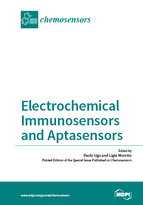Electrochemical Immunosensors and Aptasensors
A special issue of Chemosensors (ISSN 2227-9040).
Deadline for manuscript submissions: closed (31 August 2016) | Viewed by 88136
Special Issue Editors
Interests: molecular electrochemistry; electrochemosensors and biosensors; environmental electroanalysis; nanoelectrodes and bio-nanoelectrochemistry
Special Issues, Collections and Topics in MDPI journals
Interests: development of electrochemical sensors and biosensors for electrochemical and biomedical applications; environmental electroanalysis; modified electrodes; nanoelectrodes and arrays of nanoelectrodes; nanostructured electrodes
Special Issues, Collections and Topics in MDPI journals
Special Issue Information
Dear Colleagues,
The possibility to integrate biorecognition elements into electrochemical detection systems has opened the way to a new class of powerful analytical devices named electrochemical (EC) biosensors. The first EC biosensors have employed enzymes as recognition element, however this has limited their application to redox enzymes and their natural or artificial redox substrates or inhibitors. The widening towards non-electroactive analytes was later possible thanks to the development of affinity sensors in which specific interactions between biomolecules are exploited for developing highly selective and sensitive biosensors. Presently, the combination of the exceptional molecular recognition capabilities of antibodies and aptamers with the sensitivity, low cost, practicality of use and handiness of electrochemical devices is leading to an impressive development of EC immunosensors and aptasensors, potentially suitable to detect a wide range of analytes, mainly (but not only) of a proteic nature, following a path that is moving side by side with the most recent advances in proteomics. Interestingly, together with continuous improvements and refinements in EC immunosensors based on the use of labels, intrinsically electroactive or able to interact with electroactive molecules, a new generation of label-free sensors is being developed.
The aim of this Special Issue of Chemosensors is take stock of the state of the art and identify prospects for EC immuno- and aptasensors, both labeled and label-free. Emphasis will be placed on analytical applications for the rapid detection of markers of diseases (e.g., cancer or heart attack), for toxicological and environmental control, for food safety and cultural heritage diagnostics.
Prof. Dr. Paolo Ugo
Prof. Dr. Ligia Moretto
Guest Editors
Manuscript Submission Information
Manuscripts should be submitted online at www.mdpi.com by registering and logging in to this website. Once you are registered, click here to go to the submission form. Manuscripts can be submitted until the deadline. All submissions that pass pre-check are peer-reviewed. Accepted papers will be published continuously in the journal (as soon as accepted) and will be listed together on the special issue website. Research articles, review articles as well as short communications are invited. For planned papers, a title and short abstract (about 100 words) can be sent to the Editorial Office for announcement on this website.
Submitted manuscripts should not have been published previously, nor be under consideration for publication elsewhere (except conference proceedings papers). All manuscripts are thoroughly refereed through a single-blind peer-review process. A guide for authors and other relevant information for submission of manuscripts is available on the Instructions for Authors page. Chemosensors is an international peer-reviewed open access monthly journal published by MDPI.
Please visit the Instructions for Authors page before submitting a manuscript. The Article Processing Charge (APC) for publication in this open access journal is 2700 CHF (Swiss Francs). Submitted papers should be well formatted and use good English. Authors may use MDPI's English editing service prior to publication or during author revisions.
Keywords
- Electrochemical sensors
- Biosensors
- Immuno-test
- Aptamers
- Protein detection
- Voltammetry
- Amperometry
- Electrochemical impedance
- Functional electrodes







